Protein-losing enteropathy recurrence after pediatric heart transplantation: Multicenter case series
Abstract
Background
Protein-losing enteropathy (PLE) is a devastating complication of the Fontan circulation. Although orthotopic heart transplantation (HTx) typically results in resolution of PLE symptoms, isolated cases of PLE relapse have been described after HTx.
Methods
Patients with Fontan-related PLE who had undergone HTx at participating centers and experienced relapse of PLE during follow-up were retrospectively identified. Available data related to pre- and post-HTx characteristics and PLE events were collected.
Results
Eight patients from four different centers were identified. Median time from Fontan procedure to the development of PLE was 8 years, and median age at HTx was 17 years (range 7.7–21). In all patients, PLE resolved at a median time of 1 month after HTx (0.3–5). PLE recurrences occurred at a median time of 7.5 months after HTx (2–132). Each occurrence was associated with one or more significant clinical events; most commonly cellular- or antibody-mediated rejection; and less commonly graft dysfunction, infection, thrombosis, and posttransplant lymphoproliferative disease. PLE recurrences resolved after the successful treatment of the concomitant event, after a median time of 2 months in seven cases, while persisted and recurred in one patient in association with atypical mycobacterium infection and subsequent PTLD onset and relapses. Six patients were alive during follow-up at a median time of 4 years (1.3–22.5) after HTx.
Conclusions
This is the largest series of PLE recurrence after HTx. All cases were associated with one or more concomitant and significant clinical events. PLE typically resolved after resolution of the inciting clinical event.
CONFLICT OF INTEREST
Authors have no interests to disclose.
Open Research
DATA AVAILABILITY STATEMENT
The data used to support the findings of this study are included within the article.




